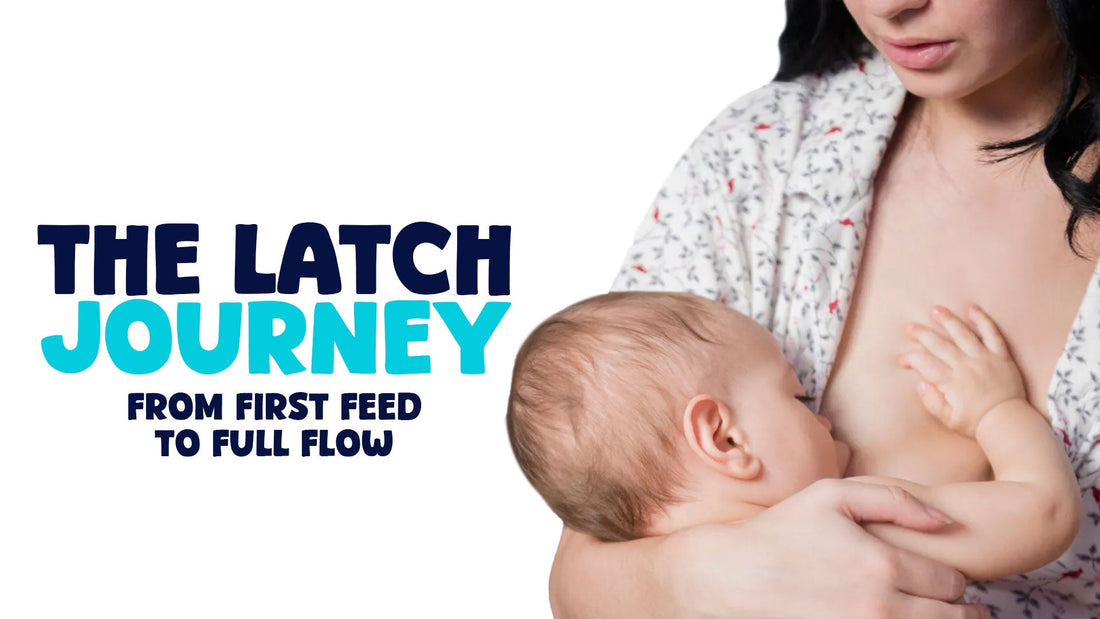
The Latch Journey: From First Feed to Full Flow
Share
Introduction: A Mother’s First Connection
The first time your baby latches isn’t just about feeding — it’s the beginning of a lifelong bond.
For new moms in Pakistan, breastfeeding can be both beautiful and challenging. From learning how to get a good latch to managing milk flow and supply, every step is part of what we call “The Latch Journey.”
The First Feed: Building the Bond
Right after birth, your baby’s natural instinct is to seek your breast — this is known as the rooting reflex.
The first latch, also called the “golden hour,” is a magical moment that sets the foundation for breastfeeding success. During this time:
- Your baby learns how to suck and swallow effectively.
- Your body begins producing colostrum, the thick golden milk rich in antibodies that protect your newborn.
- The emotional and hormonal bond between mother and baby begins to deepen.
Getting the Latch Right
A good latch ensures your baby gets enough milk while keeping you comfortable and pain-free.
Here’s how to help your baby latch effectively:
- Bring your baby to your breast, not the other way around.
- Make sure your baby’s mouth covers most of the areola, not just the nipple.
- You should feel a gentle tug, not sharp pain.
- Listen for rhythmic sucking and swallowing — that’s a great sign your baby is feeding well!
From First Drops to Full Flow
In the first few days, your milk may seem limited — and that’s perfectly normal. Around day 3–5, your milk “comes in,” and your breasts may feel fuller.
To help your milk flow naturally and consistently:
- Nurse frequently — follow the 6-6-6 rule or aim for 8–12 feeds in 24 hours.
- Stay hydrated with plenty of water or traditional drinks like sattu, barley water, or warm milk with fennel seeds.
- Eat balanced meals rich in methi (fenugreek), ajwain, and saunf — all known desi superfoods for lactation.
- Manage stress — relaxation helps your body produce more milk efficiently.
Pumping and Storing Milk
For working Pakistani moms or those juggling home responsibilities, pumping is a great way to continue the feeding journey with ease.
- Use Mumyfy’s electric breast pump for comfort and efficiency.
- Store milk in sterile storage bags, labeled with the date and time.
- Keep expressed milk refrigerated for up to 4 days or frozen for up to 6 months.
- Warm it gently by placing the bottle in warm water — avoid microwaving.
Common Latch Challenges (and Solutions!)
Even the most loving journeys have bumps along the way. Here are a few common challenges — and how to handle them:
-
Sore Nipples:
Try changing your feeding position or applying nipple cream for relief. -
Engorgement:
Express a little milk before feeding to soften the breast and help your baby latch better. -
Baby Sleepiness:
Gently tickle your baby’s feet or cheek to keep them awake and engaged during feeds. -
Low Supply:
Increase skin-to-skin contact, feed more often, and include oats or fenugreek in your diet to naturally boost production.
The Emotional Side of Breastfeeding
Breastfeeding isn’t just physical — it’s deeply emotional. Many Pakistani moms feel pressure to “get it right,” but what truly matters is the love and connection you build with your baby.
Whether you breastfeed directly, pump, or do both, you are nurturing your child in the most loving way possible. 💞
Conclusion: Every Drop Counts
The Latch Journey is more than just feeding — it’s about nurturing your baby, your body, and your confidence.
Each feed, each cuddle, and each drop of milk strengthens a bond that lasts a lifetime.
If you’re struggling, remember you’re not alone. Use Mumyfy’s best breast pumps for comfort and efficiency, and join local mom support groups in Pakistan with us.
Because motherhood is always easier — and more beautiful — when shared. 🩵
